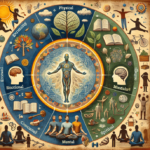Achieving Brilliant Fulfillment Through Strategic Planning
In today's fast-paced world, achieving fulfillment can be challenging. According to a 2023 study by the American Psychological Association, over 60% of individuals report feeling overwhelmed by information overload and competing demands on their time. However, with strategic planning, you can navigate these challenges and live a meaningful, purposeful, and satisfying life.
The Importance of Strategic Planning in Achieving Fulfillment
Strategic planning involves defining a clear vision, mission, and set of goals, then crafting a roadmap to achieve them. Whether for personal development or organizational growth, strategic planning is a critical tool for success. According to a 2022 report by McKinsey & Company, organizations with robust strategic planning processes are 30% more likely to exceed their growth targets.
Strategic planning helps you focus on what truly matters, prioritize actions, and make informed decisions. By aligning your efforts with your core values and purpose, you create a clear path forward, enhancing motivation and accountability even in the face of obstacles.
Furthermore, strategic planning enables proactive anticipation of potential challenges and the development of contingency plans. It also facilitates the identification of growth opportunities and fosters innovation, ensuring you stay ahead in a competitive landscape. Without a strategic plan, there's a risk of reacting to events rather than shaping your trajectory, potentially leading to missed opportunities and less favorable outcomes.
Understanding the Elements of a Successful Strategic Plan
A successful strategic plan comprises several key components: a clear vision and mission statement, SMART goals, an actionable plan, a SWOT analysis, and Key Performance Indicators (KPIs) for tracking progress. Let's delve into each element.
Vision and Mission Statements
Your vision and mission statements define your aspirations and the purpose behind them. A compelling vision statement should be aspirational and inspiring, while a mission statement should be specific and actionable. For instance, a personal vision might be, "To live a life filled with purpose, passion, and joy, inspiring others to do the same," whereas a mission statement could be, "To develop a successful online business that delivers value to customers and supports a flexible, fulfilling lifestyle."
SMART Goals
SMART goals are designed to be Specific, Measurable, Achievable, Relevant, and Time-bound. This framework ensures that goals are clear and attainable, providing a structured approach to tracking progress. Breaking down SMART goals into smaller, manageable tasks enhances focus and motivation, facilitating continuous advancement towards larger objectives.
Action Plan
Your action plan outlines the specific tasks and activities necessary to achieve your goals. It should detail deadlines, milestones, and required resources, ensuring realism and achievability. A well-structured action plan serves as a roadmap, guiding your efforts systematically toward desired outcomes.
SWOT Analysis
A SWOT analysis evaluates Strengths, Weaknesses, Opportunities, and Threats. This strategic tool helps you understand internal and external factors that can impact your plan. By identifying strengths and opportunities, you can leverage them for growth, while recognizing weaknesses and threats allows you to develop strategies to mitigate risks.
Key Performance Indicators (KPIs)
KPIs are measurable values that indicate progress toward your goals. They should be specific, measurable, and directly related to your objectives. Regularly reviewing KPIs enables you to make data-driven decisions, ensuring that you remain on track and can adjust strategies as needed.
Adapting Your Plan as Needed: Flexibility and Agility in Strategic Planning
Strategic planning is an ongoing process that requires flexibility and agility. It involves regular monitoring, evaluation, and adjustments to stay aligned with changing circumstances. According to a 2023 report by Deloitte, agile organizations are 50% more likely to respond effectively to market changes.
Incorporating regular check-ins and reviews into your plan helps identify areas that may require adjustments. Staying informed about industry trends and evolving conditions allows you to pivot or change direction proactively, maintaining alignment with your goals.
Embracing experimentation and calculated risks can also foster adaptability. Trying new approaches keeps you ahead of the curve and better equipped to handle unforeseen challenges.
Communicating Your Plan: Engaging Stakeholders and Aligning Efforts
Effective communication is pivotal in strategic planning. Ensuring that all stakeholders understand and support your vision, mission, and goals fosters alignment and commitment. Clear, concise, and consistent communication enhances collaboration and motivation across teams.
Regular meetings and updates are effective ways to engage stakeholders. According to a 2022 study by Harvard Business Review, organizations that communicate strategy effectively are 3.5 times more likely to outperform their peers.
Hosting town hall meetings or conducting focus groups can also gather valuable feedback and ideas, strengthening buy-in and fostering a sense of ownership among stakeholders.
Measuring and Evaluating Your Results: Continuous Improvement and Learning
Continuous improvement hinges on the ability to measure and evaluate results. Analyzing KPIs allows you to assess performance, identify successes, and pinpoint areas for improvement. By embracing a culture of learning, you can optimize your strategies and achieve better outcomes over time.
Setting realistic goals is fundamental to effective measurement. SMART goals facilitate clarity and focus, ensuring that progress is measurable and aligned with your objectives.
Feedback from customers, employees, and other stakeholders provides critical insights into what's working and what needs adjustment. Leveraging this feedback informs decision-making and supports ongoing enhancement of your strategic plan.
Celebrating Successes and Learning from Failures: A Growth Mindset in Strategic Planning
Maintaining a growth mindset is essential in strategic planning. Celebrating successes reinforces positive behaviors and accomplishments, boosting morale and motivation. Conversely, viewing failures as learning opportunities fosters resilience and continuous development.
Recognizing and rewarding achievements, both personally and within your team, cultivates a positive environment conducive to sustained progress. Learning from setbacks encourages adaptive strategies and supports long-term success.
In conclusion, achieving brilliant fulfillment through strategic planning is attainable with a structured approach that incorporates vision, goal-setting, flexibility, effective communication, and continuous evaluation. By adopting these practices and fostering a growth mindset, you can reach your goals, find personal fulfillment, and make a meaningful impact.
Maintaining a growth mindset requires ongoing dedication and reflection. Consistently assessing your progress, adjusting strategies, and striving for improvement ensures that you remain adaptable and poised for long-term success.




















